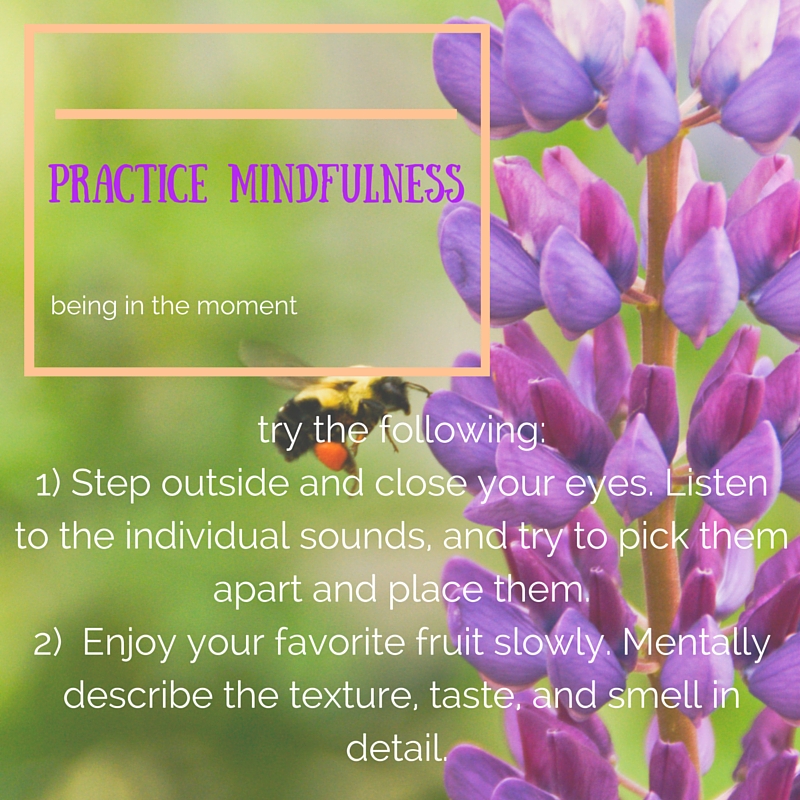
Mindfulness
The other week, during my lunch break, I decided to eat outside to try and enjoy the sunshine knowing very well it’ll be gone very soon. Almost immediately after I sat down at a table to eat, an eccentric man wearing neon bike shorts and a leopard tank top sat next to me. I will be honest and admit that I wasn’t in the mood to chat in general, let alone with a total stranger; but suffice it to say, this man was. He started off with small talk and quickly delved into more philosophical subjects, specifically Time as a concept. He was in his mid forties and explained to me how it had taken him all these years to realize how important it was to stay in the present and how he felt like he had lost so many years of his life due to worrying about his future or his past.
That last point really resonated with me. Most people would be able to relate to that idea, but it’s even more relevant for people who suffer from anxiety and/or depression. Too often, unwanted and unwarranted negative emotions come over us when we spend too much time thinking about future events, and/or ruminating about past ones—what’s worse, we often do this without being fully aware of it. Luckily, there is one easy way to avoid this vicious cycle: simply stay in the moment and practice mindfulness.
Jon Kabat-Zinn, the founder of ‘Mindfulness-Based Stress Reduction,’ defines mindfulness best. He says mindfulness is “paying attention on purpose, in the present moment, and non-judgmentally, to the unfolding of experience moment to moment.” That is to say, practicing mindfulness focuses on staying in the moment—the here and now—without judgment and with intention. The benefits of incorporating this practice into your routine has been shown to not only bring improvements in psychological symptoms, but physical symptoms as well. It also has been demonstrated to bring positive changes in behavior, and attitude toward health. Mindfulness-based approaches have been used with high success rates in various psychotherapy treatments such as Cognitive Behavioral Therapy (CBT) and Dialectical Behavior Therapy (DBT).
Of course, understanding how effective mindfulness can be, and to what great effect it’s been used in various contexts, doesn’t quite help you figure out how to get started using it right now. “Easier said than done,” you might be saying to yourself. While that adage so often rings true, practicing mindfulness really is simpler than you might assume, and it only takes a few minutes a day.
If you’re new to meditation, try and find a peaceful and quiet space to focus on your breathing for just five minutes. Notice when your mind starts to wander (trust me, it will). When this happens, try and bring your attention back to your breathing. The point of this exercise is not to judge yourself or your thoughts, but instead, it’s meant to help you view and observe your thoughts as completely separate from yourself, and allow them float away.
It’s easy to forget to stay in the moment, especially with so many everyday obligations that require logistical forethought and planning, but taking just a few minutes a day can help you to stay calm and less anxious during such stressful situations. I have to say that I am grateful for that lunchtime chat I had with my newfound friend. He helped me to remember the advantages of staying in the now and the myriad benefits to being mindful. In essence, he reminded me to remain mindful about being mindful. In a way, our conversation itself was a metaphor for mindfulness; had I not been present at that moment, thinking about getting out of the encounter and how I would do it, I wouldn’t have been open to what he was saying and wouldn’t have learned anything from it. After I finished eating, I stood up to leave and thanked him for his insight, and as I left he shouted to me, “Stay present!”
